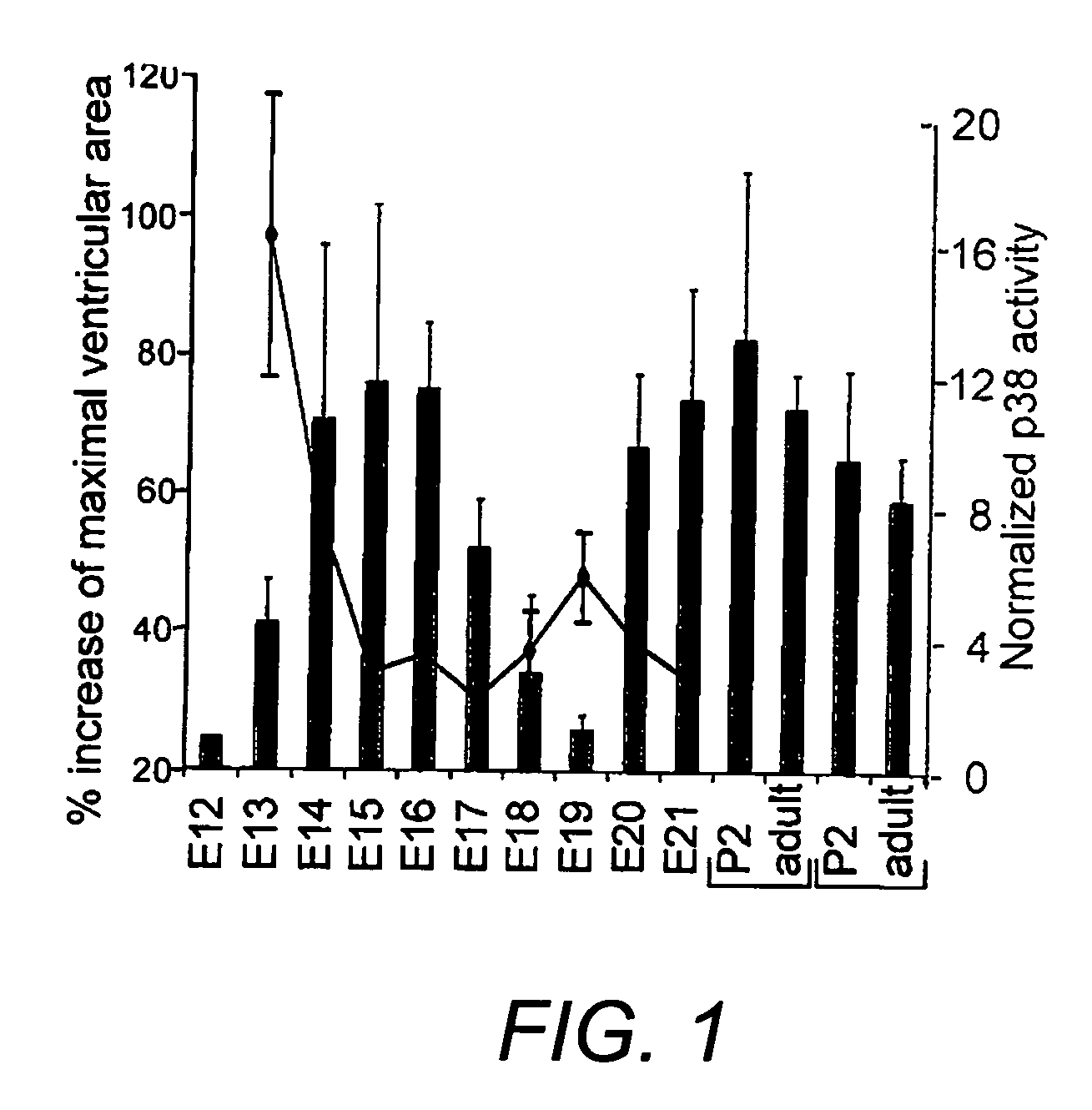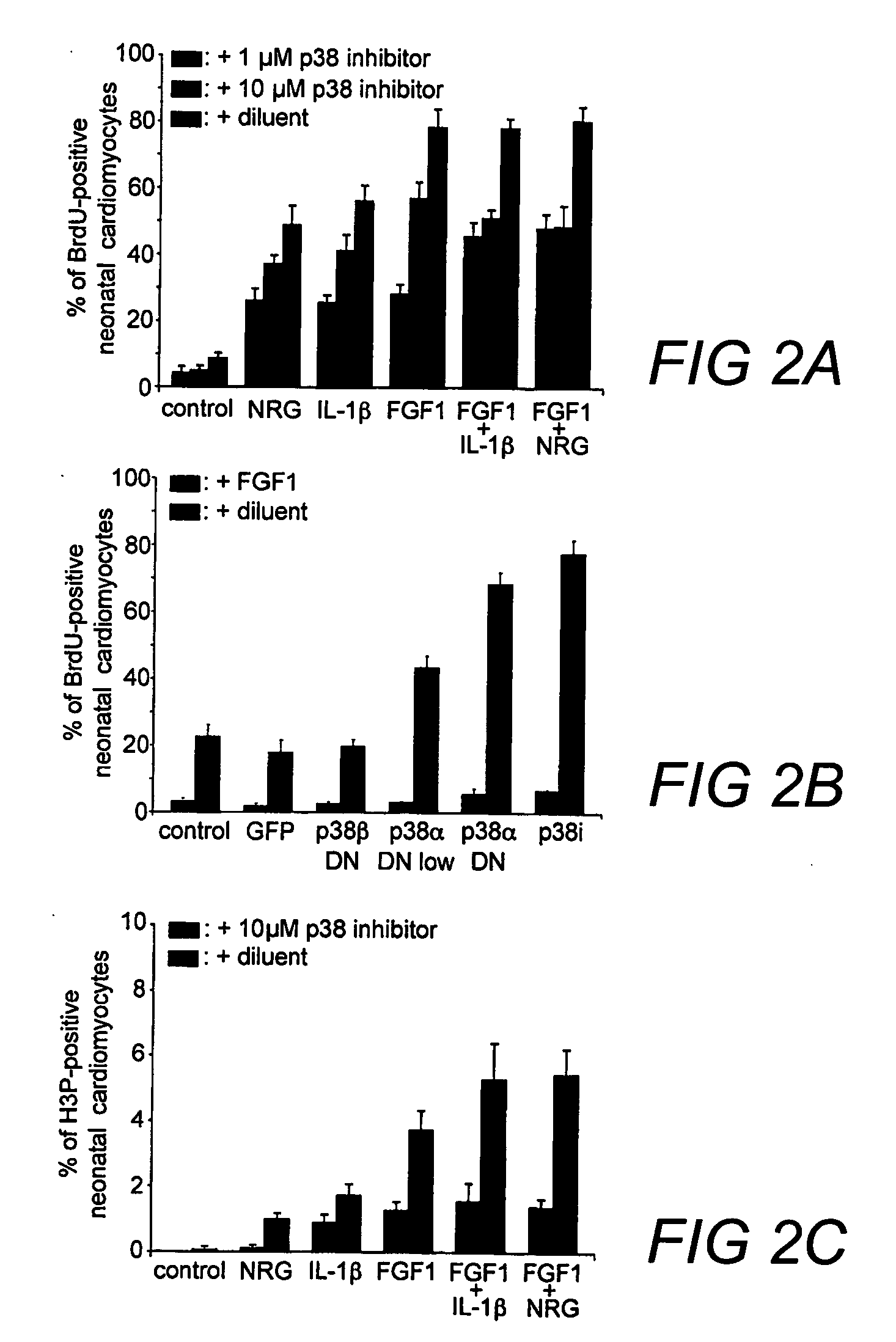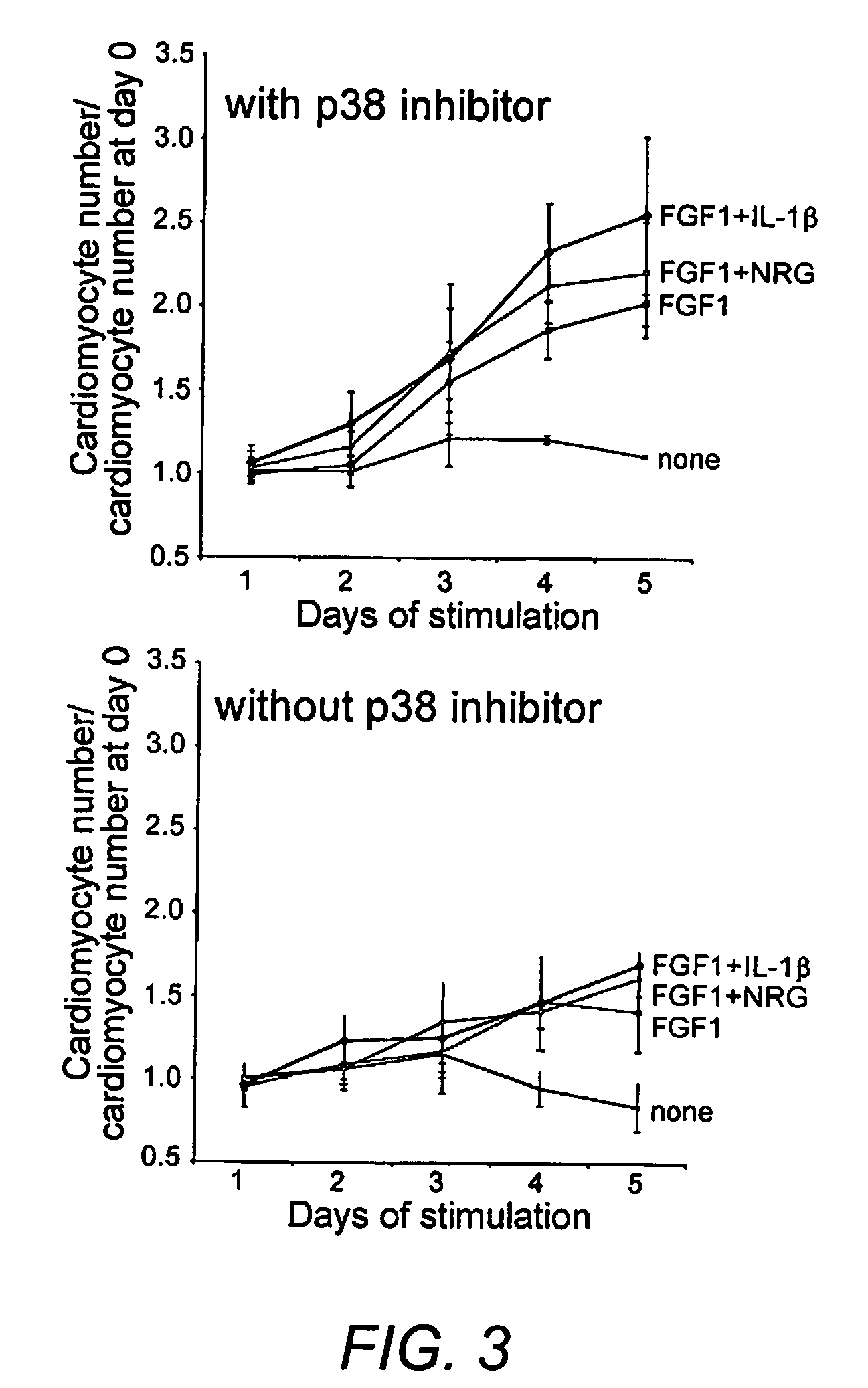Methods of increasing proliferation of adult mammalian cardiomyocytes through p38 map kinase inhibition
a technology of fetal cardiomyocytes and p38 map, which is applied in the direction of biocide, drug composition, peptide/protein ingredients, etc., can solve the problems of cardiac muscle loss, slow down, reduce or prevent the onset of cardiac damage, and increase the proliferation of fetal cardiomyocytes. , to achieve the effect of blocking the proliferation of fetal cardiomyocytes, slowing down the onset of cardiac damage, and slowing down the de-differen
- Summary
- Abstract
- Description
- Claims
- Application Information
AI Technical Summary
Benefits of technology
Problems solved by technology
Method used
Image
Examples
example 1
De-Differentiation and Proliferation of Adult Cardiomyocytes
Animals, Cells, and Stimulation
[0102] Animal experiments were performed in accordance with guidelines of Children's Hospital, Boston and UCLA. Ventricular cardiomyocytes from fetal (E19), 2-day-old (P2) and adult (250-350 g) Wistar rats (Charles River) were isolated as described with minor modifications (Engel et al. 1999; Engel et al. 2003). After digestion of fetal or neonatal hearts (0.14 mg / ml collagenase II (Invitrogen), 0.55 mg / ml pancreatin (Sigma)) cells were cultured in DMEM / F12 (GIBCO) containing 3 mM Na-pyruvate, 0.2% BSA, 0.1 mM ascorbic acid (Sigma), 0.5% Insulin-Transferrin-Selenium (100×), penicillin (100 U / ml), streptomycin (100 μg / ml), and 2 mM L-glutamine (GIBCO). Adult cardiomyocytes were cultured for 1 day in standard medium (DMEM, 25 mM Hepes, 5 mM taurine, 5 mM creatine, 2 mM L-carnitine (Sigma), 20 U / ml insulin (GIBCO), 0.2% BSA, penicillin (100 U / ml), and streptomycin (100 μg / ml)). Cells were stim...
example 2
In Vivo Effects of p38 Inhibitors Following Myocardial Infarct
[0137] The effects of a variety of p38 inhibitors on adult rat cardiomyocytes were compared using Ki67, BrdU, and H3P (FIG. 5A shows the percentage of Ki67-positive neonatal cardiomyocytes. FIG. 5B shows the percentage of BrdU-positive neonatal cardiomyocytes and (FIG. 5C shows the percentage of H3P-positive neonatal cardiomyocytes). The compounds tested in FIGS. 5A-5C include SB203580, which has 100- to 500-fold selectivity over GSK3β and PKBα, SB203580 HCL (water insoluble), SB202474, a negative control commonly use for MAP kinase inhibition studies, and SB239063 which has >200-fold selectivity over ERK and JNK.
[0138] The p38 inhibitors were tested for in vivo effect following myocardial infarct. For the evaluation of left ventricular function, transthoracic echocardiogram can be performed on the rats after myocardial infarction 1 day or 14 days right. Rats can be anesthetized with 4-5% isoflurane in an induction cham...
example 3
Further In Vivo Effects of p38 Inhibitors Following Myocardial Infarct
[0141] To determine whether p38 inhibition / FGF1 stimulation can induce cardiomyocyte proliferation in vivo and whether it has a positive effect on cardiac function after cardiac injury we created myocardial infarctions (MI) in adult rats (250 g) by coronary artery ligation. The p38 inhibitor SB203580 HCl or its vehicle, saline, were injected intraperitoneal every three days for the first month of the study. FGF1 or its carrier BSA was injected mixed with self-assembling peptides once into the infarct border zone immediately after coronary artery ligation. We injecting a total of 80 μl of 400 ng / ml FGF1, given at 3 different injection sites, into 400 mg of infarcted myocardium estimated to deliver a FGF 1 concentration to the cardiomyocytes of approximately 50 to 100 ng / ml. Animals were analyzed 24 hours, 2 weeks, and 3 month after surgery. We performed two blinded and randomized studies using 62 rats for the 2 we...
PUM
| Property | Measurement | Unit |
|---|---|---|
| concentration | aaaaa | aaaaa |
| concentration | aaaaa | aaaaa |
| end-diastolic diameter | aaaaa | aaaaa |
Abstract
Description
Claims
Application Information
 Login to View More
Login to View More - R&D
- Intellectual Property
- Life Sciences
- Materials
- Tech Scout
- Unparalleled Data Quality
- Higher Quality Content
- 60% Fewer Hallucinations
Browse by: Latest US Patents, China's latest patents, Technical Efficacy Thesaurus, Application Domain, Technology Topic, Popular Technical Reports.
© 2025 PatSnap. All rights reserved.Legal|Privacy policy|Modern Slavery Act Transparency Statement|Sitemap|About US| Contact US: help@patsnap.com



